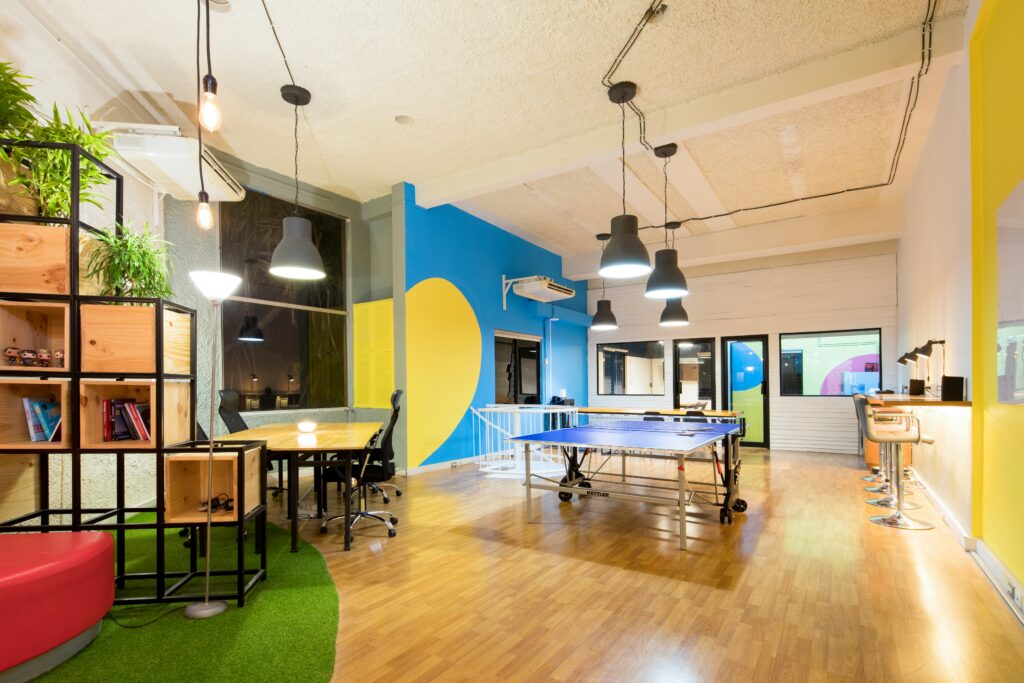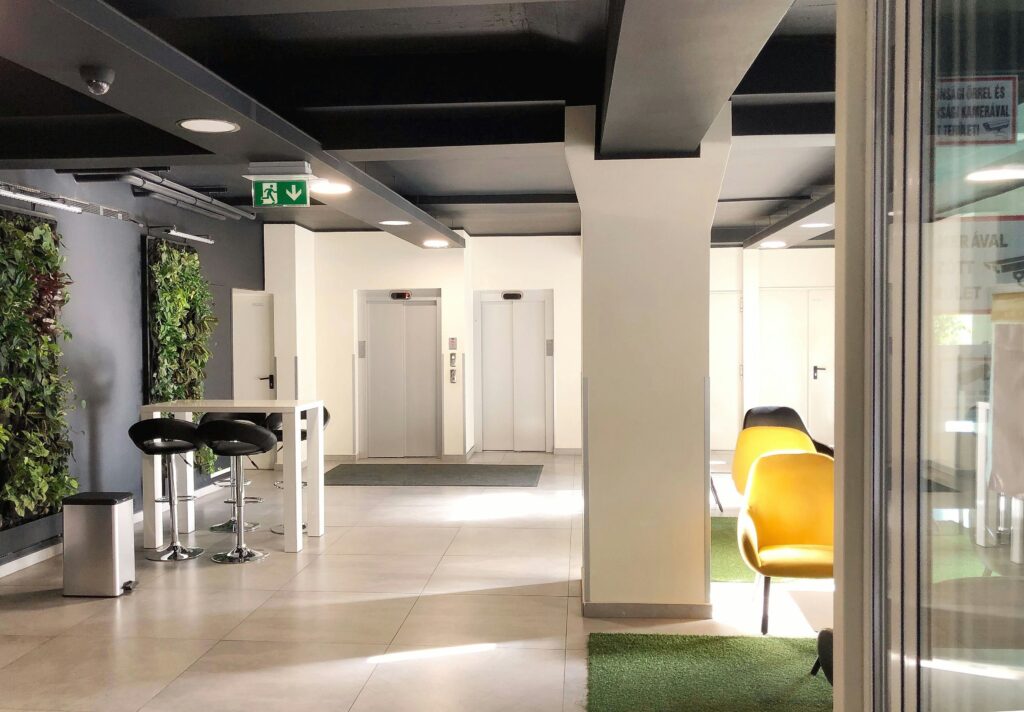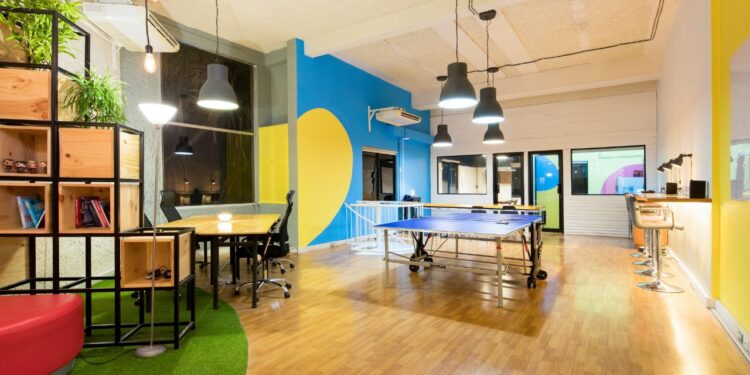- Workspace design enhances productivity, and innovative layouts in coworking spaces can increase member attraction and revenue.
- Modular design and adaptable furniture allow for flexible use of space, catering to various member needs and optimizing potential income.
- Investing in technology and high-quality resources improves member satisfaction and loyalty, ultimately driving long-term financial returns.
In today’s crowded coworking world, offering just a desk and coffee isn’t enough to stand out. Over 90% of employees say workspace design has a direct impact on how productive they feel.
For coworking operators to truly succeed, a coworking space has to offer more than just a place to work — it needs to spark inspiration and connection. That’s where innovative layouts come in.
Envision a coworking space that effortlessly adapts to everyone’s needs. A freelancer finds a quiet corner to focus, a startup has room to brainstorm their next big idea, and even a corporate team feels at home in the flexible environment.
By using adaptable layouts, the right technology, and thoughtfully designed work zones, you’re not just maximizing your space; you’re creating an experience that attracts members and boosts your bottom line.
Companies that invest in smart design see a huge boost in their returns — a whopping 219% greater than those who don’t.
Modular Design for Revenue Optimization
Let’s face it, major renovations in a coworking space can be a nightmare; they’re expensive, disruptive, and, worst of all — they limit your options. That’s why modular design is your budget-friendly superpower.
Think of it like a building with giant, stylish Lego bricks. Here’s how it transforms your space and your revenue potential:
Adapting, not renovating
One potential idea is moveable walls that let you create enclosed rooms without knocking down drywall. Lightweight furniture that rolls and rearranges in a flash, allows you to swiftly have a workshop space instead of a sea of desks.
This kind of flexibility means you’re not locked into a single configuration. Need a private office space for a day? Modular design lets you create it on demand.
Every square foot becomes an opportunity
With truly flexible layouts, you can rent out your spaces for more than just desk work. Host workshops in reconfigured open areas, offer private offices created on the spot, or transform your lounge into a unique event space after hours.
Every inch of your space becomes a potential revenue generator.
Flexibility is your biggest selling point
Imagine pitching potential members on an office space that changes based on their needs. Startups will be drawn to your collaborative zones, while freelancers might prefer dedicated focus areas. Even larger companies looking for temporary project space will see the appeal.
It’s this “workplace on-demand” concept that sets you apart from the competition.

Technology Investments That Pay Off
Technology isn’t just about having the latest gadget, it’s about making your coworking space run like a well-oiled machine. Think of it as the invisible force that creates a seamless experience for both you and your members. Here’s how it breaks down:
Happy members are loyal members
The easier you make things for members, the less likely they are to wander off to a competitor.
A smooth online booking systems where members can snag their favorite desk or meeting room in minutes, makes an incredible difference by avoiding a frustrating call. Or imagine reliable power and screen-sharing in every room — no more awkward tech fumbles during client presentations.
The easier you make things for members, the less likely they are to wander off to a competitor.
Running your space shouldn’t be a headache
You shouldn’t have to be a tech whiz to keep your operations running smoothly; the right tech platforms streamline tasks like billing, membership management, and even room temperature control. That frees up your time (and brain space) to focus on what matters: building a great coworking community.
Data is your hidden power
Smart technology isn’t just about convenience, it’s also about understanding how your space is being used, data that can be gathered by sensors that track which work zones are most popular and when.
Armed with that data, you can adjust your layout to better suit member needs. You might realize your quiet zone is too small, or that breakout areas are getting more action after 5pm.
These insights give you solid information to back up any future changes and investments.
Work Zone Planning for Member Needs
You’re not just catering to one type of worker, but a whole community made up of different personalities and work styles.
Think of your coworking space as a microcosm of the modern workplace. You’re not just catering to one type of worker, but a whole community made up of different personalities and work styles.
You’re not just catering to one type of worker, but a whole community made up of different personalities and work styles.
Creating the right mix of zones is what makes everyone feel supported and ultimately boosts productivity and satisfaction for all.

Your Member Mix
- The Focused Freelancer: They need quiet areas, minimal distractions, and maybe even soundproof booths for client calls.
- The Collaborative Startup: These teams thrive in open areas with whiteboards, flexible seating, and easy access to meeting rooms for brainstorming sessions.
- The Remote Corporate Team: They might be seeking professional, private offices with video conferencing setup for larger company meetings, along with spaces for casual connection with HQ’s remote workforce.
A Zone for Every Task
By thoughtfully dividing your space, you empower people to work in the style that suits them best. A buzzing open area is perfect for sparking ideas, but terrible for drafting a proposal.
Provide a variety:
- Dedicated “heads down” zones: Think cozy nooks or individual pods for deep focus
- Vibrant shared spaces: Communal tables and lounge-like seating for collaboration and informal networking
- Private meeting rooms: Equipped with the right tech for both in-person and hybrid teams
- Don’t forget the “fun” zones: A well-stocked coffee area or kitchen becomes the hub for those connections
Community Happens by Design
Yes, people join coworking spaces to work, but they stay because of the connections they make.
Yes, people join coworking spaces to work, but they stay because of the connections they make.
Clever spatial layouts play a key role in fostering that sense of belonging. Such ideas include intentional breakout spaces where people naturally cross paths, a comfy lounge area that encourages conversation, or even a designated area for hosting member-led workshops or events.
When people feel comfortable and connected, they’re more likely to see your space as their work “home.”
Cost Analysis and ROI
Upfront Costs vs. Long-term Wins
It’s tempting to think that the cheapest option is always the best for your bottom line. But when it comes to your coworking space, skimping on quality can come back to bite you. It might seem smart to save money on basic desks and a run-of-the-mill internet setup, but that decision can limit your potential down the road.
Modular furniture and seamless tech systems often have a higher price tag — that’s undeniable. But remember, you’re not just investing in physical items, you’re investing in adaptability and member experience.
Imagine how much those modular desks might earn you when configured for a high-paying workshop, or how a robust tech platform keeps members happy and reduces turnover. That long-term return on investment is where the true value lies.
The Hidden Costs of “Good Enough”
Sure, you might fill your space initially by offering a bargain price, but a coworking experience built around “good enough” quickly wears thin. Members get frustrated battling for a quiet corner or struggling with glitchy WiFi.
Losing members means losing money. Prioritizing the quality of a member’s workday through thoughtful design and reliable tech is what keeps them coming back month after month.
Calculating Your Space’s Potential
It’s time to rethink how you measure your space’s success. Ditch the mindset of maximizing the number of bodies you can cram in. Instead, focus on how each square foot can work smarter to maximize its earning potential.
Think of turning a reconfigured open area into a workshop space you rent out for $100 an hour. Or those moveable walls you invested in that allow you to instantly create on-demand private offices at $300 a day.
Add to that the higher membership fees that your seamless tech experience allows you to charge. That’s how smart spatial design transforms your space from a mere collection of desks into a financially thriving hub.
Conclusion
We started by talking about the competitive nature of the coworking landscape. But here’s the thing — innovative spatial design isn’t just about survival, it’s about unlocking your space’s true potential for success.
It’s about turning those square feet into a powerful engine for attracting new members, boosting satisfaction, and maximizing revenue on a long-term basis.
The old model of fixed desks and predictable layouts is just that: old.
By embracing adaptable design, seamless technology, and a thoughtful understanding of member needs, you’re future-proofing your business, and you’re creating a space that’s flexible enough to evolve alongside the ever-changing world of work.
So, let’s challenge the way we think about coworking. It’s about more than just providing a place for laptops and coffee. It’s about creating a dynamic, inspiring environment where people and businesses flourish.
When you invest strategically in your space, you’re investing directly in the long-term success of your coworking venture.


 Dr. Gleb Tsipursky – The Office Whisperer
Dr. Gleb Tsipursky – The Office Whisperer Nirit Cohen – WorkFutures
Nirit Cohen – WorkFutures Angela Howard – Culture Expert
Angela Howard – Culture Expert Drew Jones – Design & Innovation
Drew Jones – Design & Innovation Jonathan Price – CRE & Flex Expert
Jonathan Price – CRE & Flex Expert













